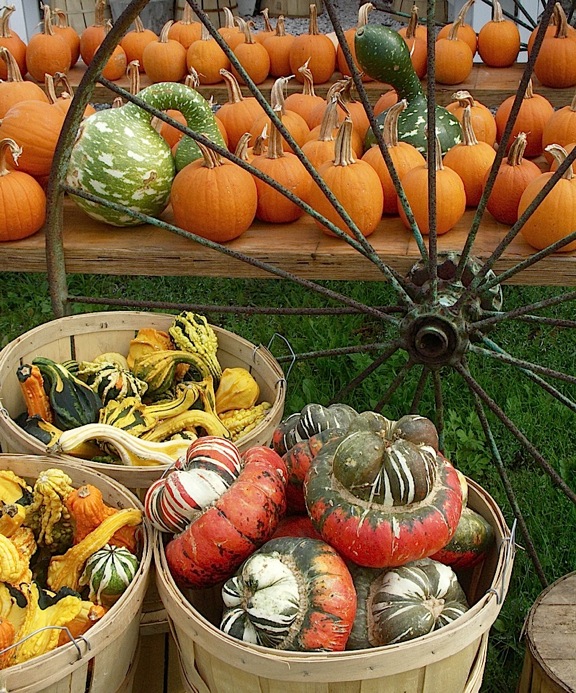MARIANI’SVirtual
Gourmet
October 28,
2012
NEWSLETTER
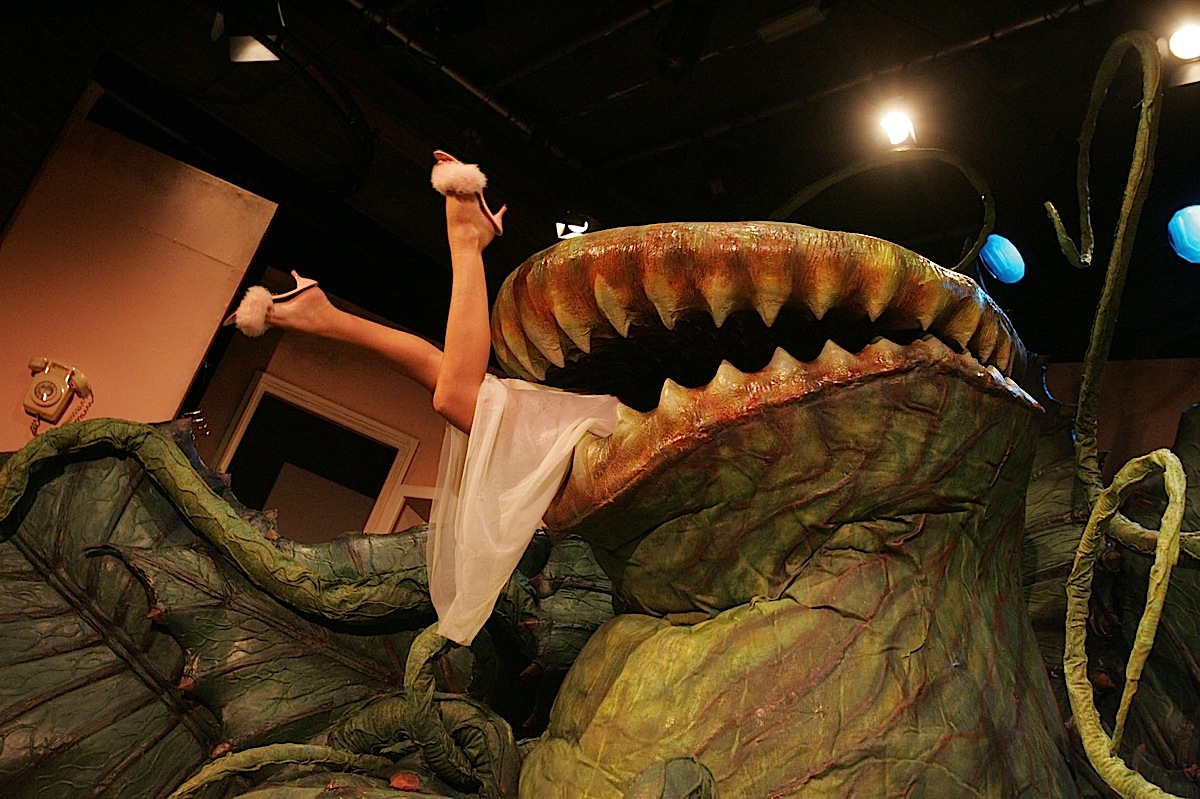
"LITTLE SHOP OF HORRORS"
HAPPY
HALLOWEEN!
❖❖❖
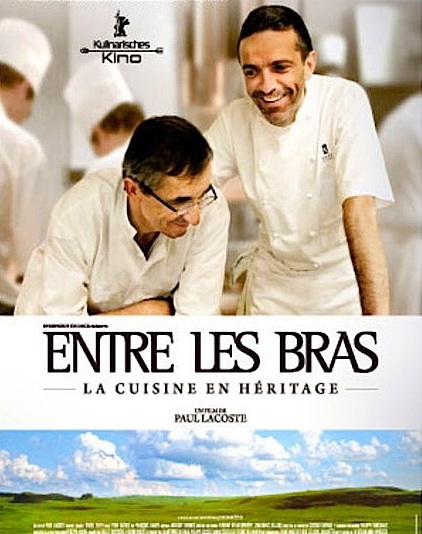
the French food film "Entre les Bras" (2010), about Master Chef
Michel Bras and his family. Guest host will be
chef Jean-Louis Gérin of Restaurant Jean-Louis in
Greenwich, CT. All screenings will be held
at Florence Gould Hall, 55 East 59th Street at 7:30 PM,
followed by Q&A with host. Tickets $10. For info click here.
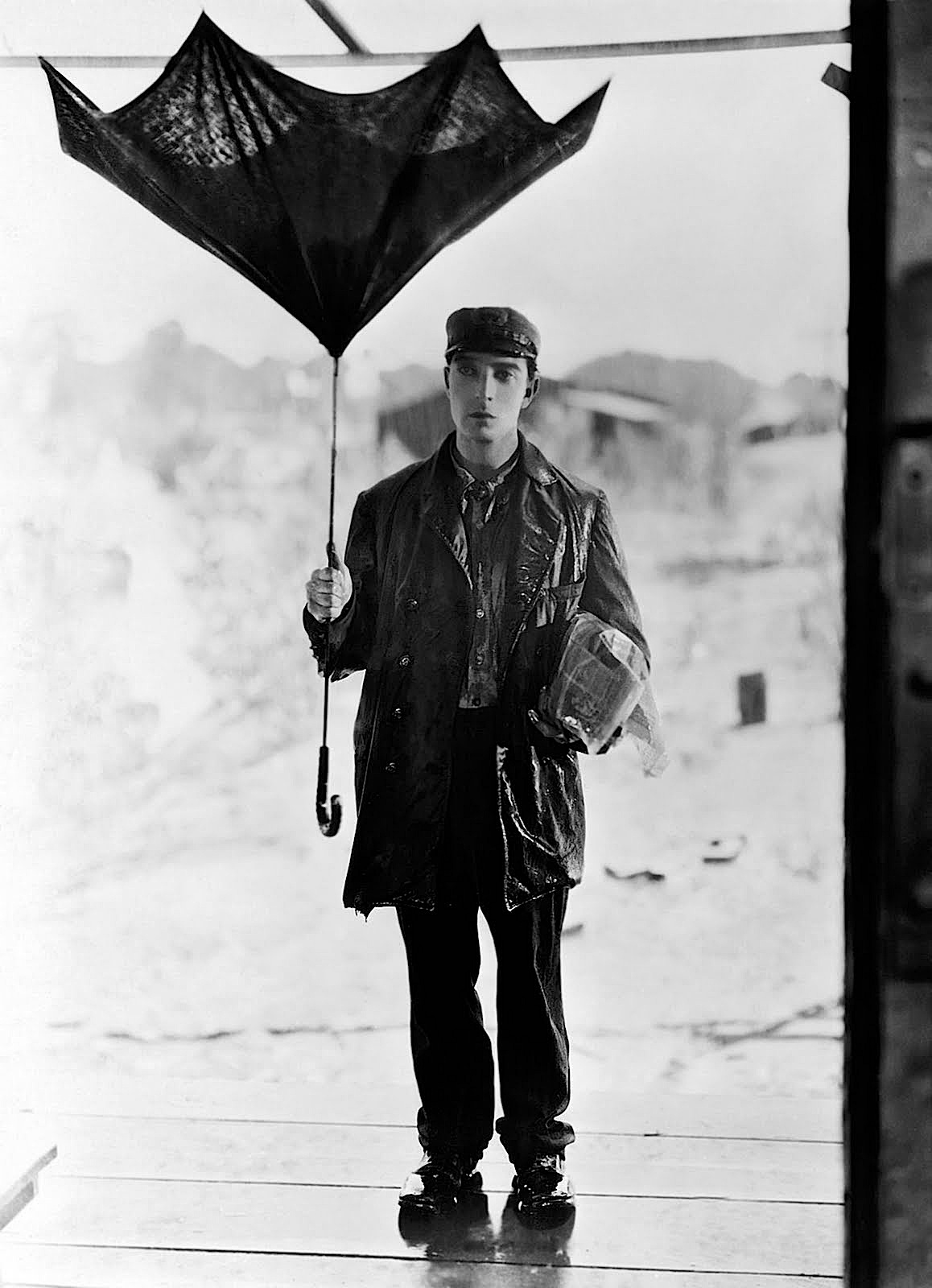
STORM WARNING!
If, owing to the arrival of Hurricane Sandy this
weekend,
you do not receive next weekend's Virtual Gourmet (Nov.
4),
it will be because I have either been swept away by
Sandy
or the power in my neighborhood is down.
Wish me luck!
--John Mariani
❖❖❖
THIS
WEEK
AUTUMN LEAVES AND DINING WELL IN
CONNECTICUT
by John Mariani
LAST
CALL FOR LOCKE-OBER?
by John Mariani
NEW YORK
CORNER
PERLA
by
John Mariani
NOTES FROM THE WINE
CELLAR
Morellino di
Scanscano
by Mort Hochstein
AUTUMN
LEAVES AND
DINING
WELL IN CONNECTICUT
English poet
John Keats did not have Connecticut in mind when he
wrote of autumn, "Season of mists and mellow
fruitfulness,/Close bosom-friend of the maturing
sun," but had he ever visited the region he might
well have done so. It's a beautiful state at any
time of year but shows off its greatest colors after
Indian summer fades. The ash trees turn purple, the
hickories and maples yellow, the oak bright red.
It's a great time for a vacation from anywhere or a
drive from New York, and you can eat well all over
the state, especially in the southern region, where
nationally heralded restaurants like Jean-Louis
and Thomas
Henkelmann at The Homestead Inn, both in
Greenwich, The
Elms Inn in Ridgefield, and The
Dressing Room in Westport have long been
distinguished. This past year a new crop has
grown up in the Nutmeg State, well deserving that
direction, worth a journey.
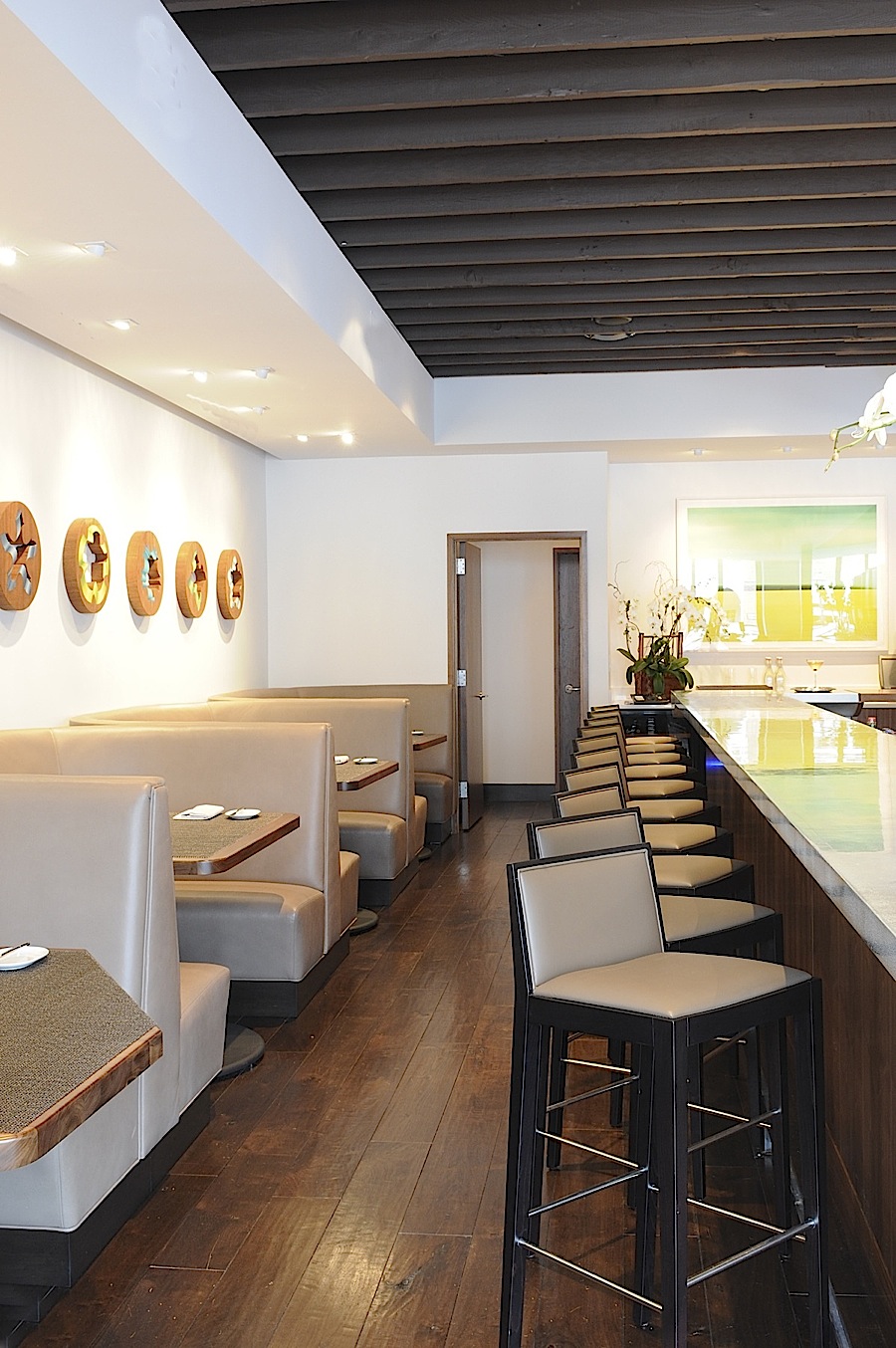 ELM
ELM
73 Elm Street
203-920-4994
www.elmrestaurant.com
Not everyone will go
anywhere for a great meal, and most people would not
think that New Canaan,
Connecticut, eighth wealthiest suburb in the U.S.,
would be where to find
one. Yet there
in the ‘burbs is
Elm, which chef-owner, Brian Lewis, calls, correctly,
“a world-class restaurant
with small town charm.”
In 2009 Esquire
honored Lewis (below)
when he was chef
at Richard Gere’s Bedford Post Inn;
now at his own place, which I honored in Esquire for 2012,
Lewis is working at
the top of his form with elegant dishes like griddled
langoustines with pearly
white garlic soup, uni butter,
prosciutto lardo,
and togarashi
chile pepper. He
invigorates black bass with 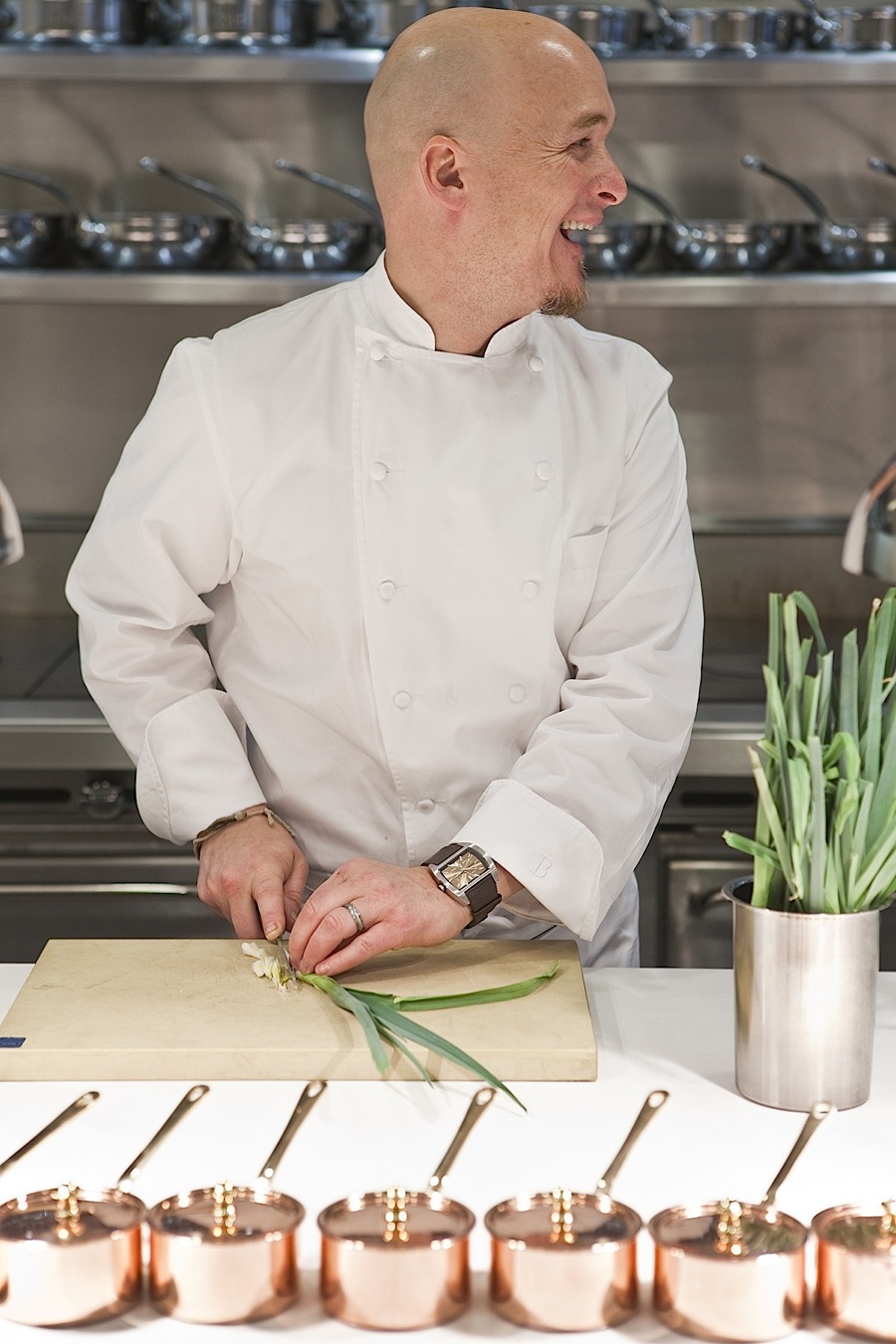 chorizo and
an eggplant aïoli, sweet
pepper oil, black olive and golden saffron, and brings
back the luster to good
old carrot cake with a carrot pudding, walnut brittle,
and caramel ice cream.
chorizo and
an eggplant aïoli, sweet
pepper oil, black olive and golden saffron, and brings
back the luster to good
old carrot cake with a carrot pudding, walnut brittle,
and caramel ice cream.
Lewis
was
born in the suburbs, and, after leaving the Inn to
find his own “stage,” he
decided against California and New York. Sounding like
Dorothy back from Oz, he
says, “I realized I had never been so inspired as I
was right here in the
country. I decided that the stage is where you make
it, you know, wherever you
go, there you are.
I’d become
highly involved with a terrific network of talented
chefs, passionate farmers
and artisan craftsman, all that any urban hot spot
would need as fuel for their
fire, only it was right here in my backyard. So we
just put our heads down and
cook from our hearts for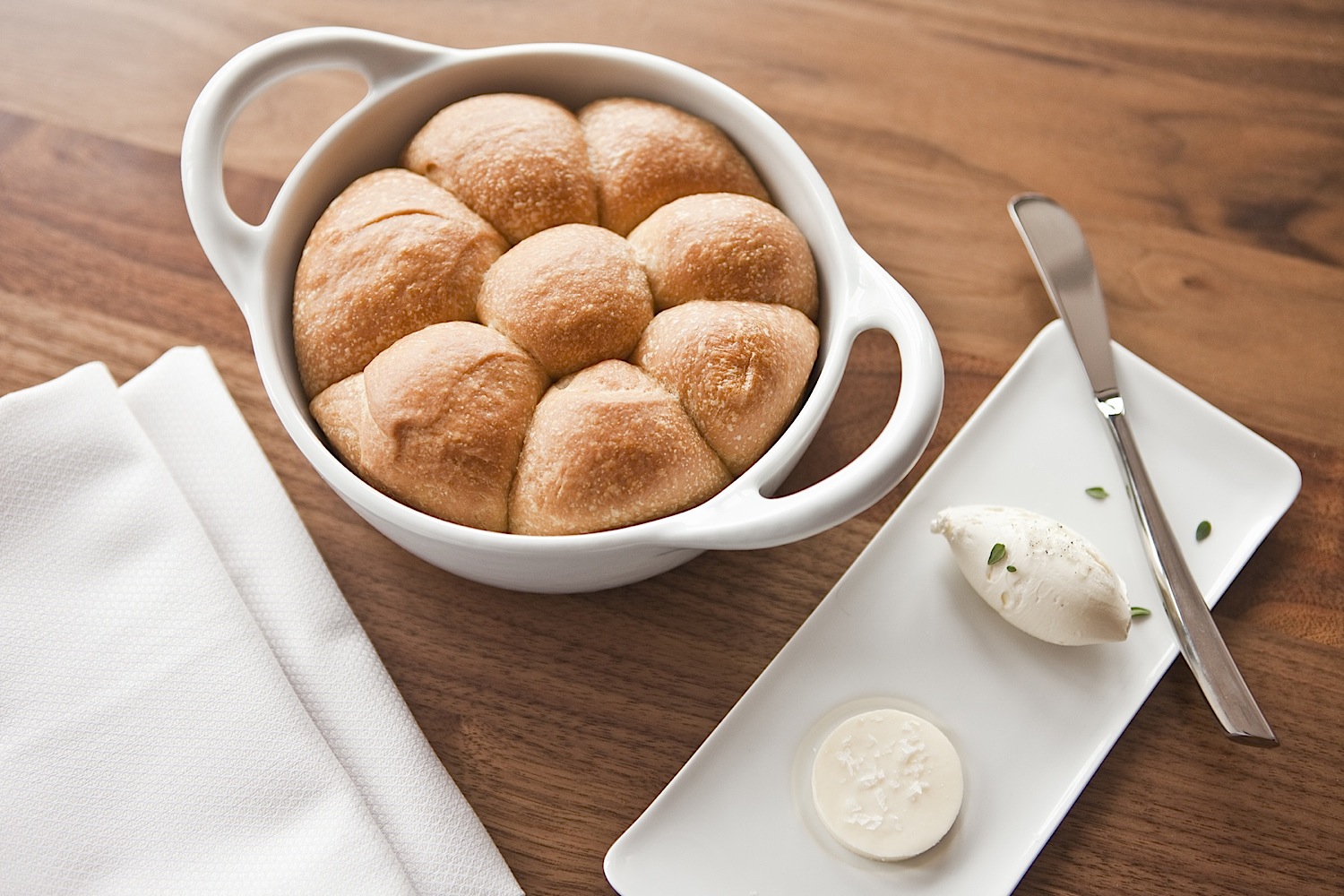 our neighbors
and those up from Manhattan who are
looking for a bit of the country and finding a taste
of New York."
our neighbors
and those up from Manhattan who are
looking for a bit of the country and finding a taste
of New York."
His commitment becomes
obvious in dishes like "crunchy" big-eye tuna with
sunchokes, soy and brown butter caramel and his
English pea sacchetti
with lemon brown butter and
pecorino--simplicity itself, delicious on every
level. A duo of veal with hazelnut crumble,
Mangalica ham, artichokes, farro, and hay ash was the
exact opposite--too much going on on one plate. But
his confit of pork with grits, stone fruit mostarda and a
soft egg blended beautifully. For the Parker House
rolls (left)
alone, Elm deserves a special trip.
There is a selection of artisanal
cheeses well worth ordering, but you don't want to
miss pastry chef
Caryn Stabinsky's excellent toffee pudding with
crème fraîche of her dark chocolate pot de creme with
ruby beet sorbet.
ARTISAN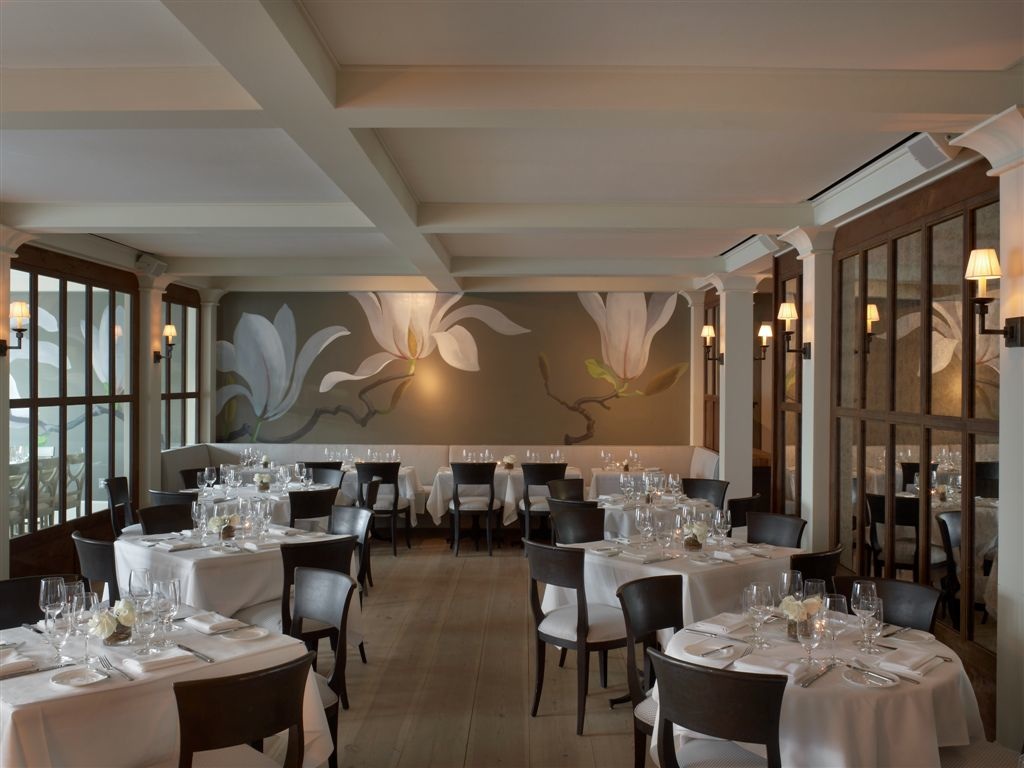
Delamar Hotel
275 Old Post Road
Southport, CT
203-307-4222
artisansouthport.com.
I have been happily tracking
Parisian-born Chef Frederic Kieffer since he was
at Gaia in Greenwich after working his way through
esteemed Paris restaurants like
Taillevent, Le Chiberta, and the Lutetia Hotel. He
was part of the re-opening
of Windows of the World, then at Water’s Edge
and Man Ray in NYC.
Now he is back in Connecticut running two kitchens,
Artisan and L'Escale (see
below), which are quite different in style
and menu.
Artisan's
name says a good deal: the
design melds Connecticut rustic with 19th century
Scandinavian furniture, oxidized
mirror
panels, copper string chandeliers, a pewter-top bar,
and a charming kakelugn,
a Swedish tile stove that
serves as a fireplace where you can sit and sip a
Cognac or Single Malt.
The
restaurant space sprawls over several rooms,
including the 50-seat Tavern,
and in good weather there are outside tables. The
place has been very popular
since opening and on crush nights, service is well
meaning but can be slow.
Kieffer’s menu is full of hearty dishes,
especially now that cooler weather is here. When I dined in warmer
weather, richness of taste abounded in
a wonderful 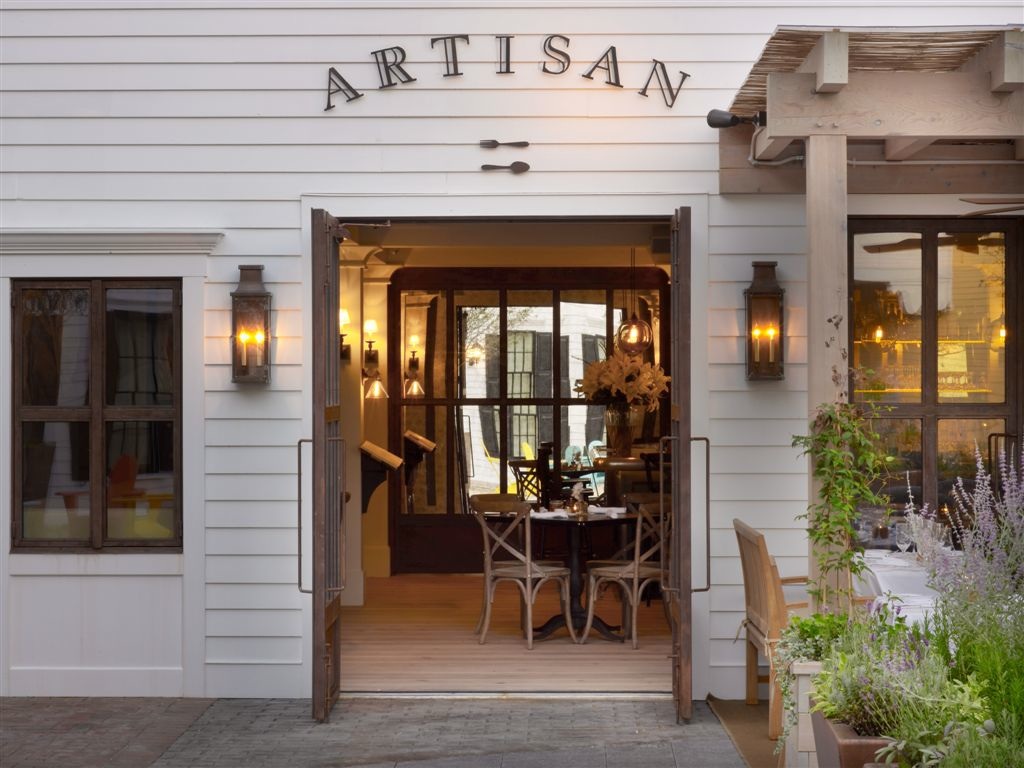 lobster
bisque that really tasted of lobster, not always a
given
elsewhere. The
same goes for a
textbook perfect chowder, teeming with chunks of
seafood and served wit a
fennel crackers.
Griddled crabcake
was bound with too much breading, but Kieffer’s
pastas are very well wrought,
including a wild mushrooms and farro risotto with
Fossa cheese from Emilia Romagna, and delicious
goat’s
cheese gnocchi with a lamb meat sauce and arugula.
lobster
bisque that really tasted of lobster, not always a
given
elsewhere. The
same goes for a
textbook perfect chowder, teeming with chunks of
seafood and served wit a
fennel crackers.
Griddled crabcake
was bound with too much breading, but Kieffer’s
pastas are very well wrought,
including a wild mushrooms and farro risotto with
Fossa cheese from Emilia Romagna, and delicious
goat’s
cheese gnocchi with a lamb meat sauce and arugula.
I liked the generous meat dishes, especially
the beef pot roast with whipped potatoes and roasted
baby vegetables and the
finely grained Berkshire pork chop, juicy
throughout, with fingerling
potatoes, apple, bacon, sweet prune and a hard cider
sauce, which is a totem of
autumn cookery.
On the night we
dined, the seafood didn't quite come up to that
standard, a dorade too strong
in taste and scallops overcooked.
It would be tough to pass up desserts like creamy
chocolate pudding with hazelnut crunch, sour
cherry-whipped cream or an
outstanding cheesecake with caramel and shake of sea
salt. Silly in an
over-the-top way but irresistible nonetheless is the
lavish banana split of
caramelized bananas, Nutella, ice creams, fudge and
almonds.
Photos by Jane Beiles
L'ESCALE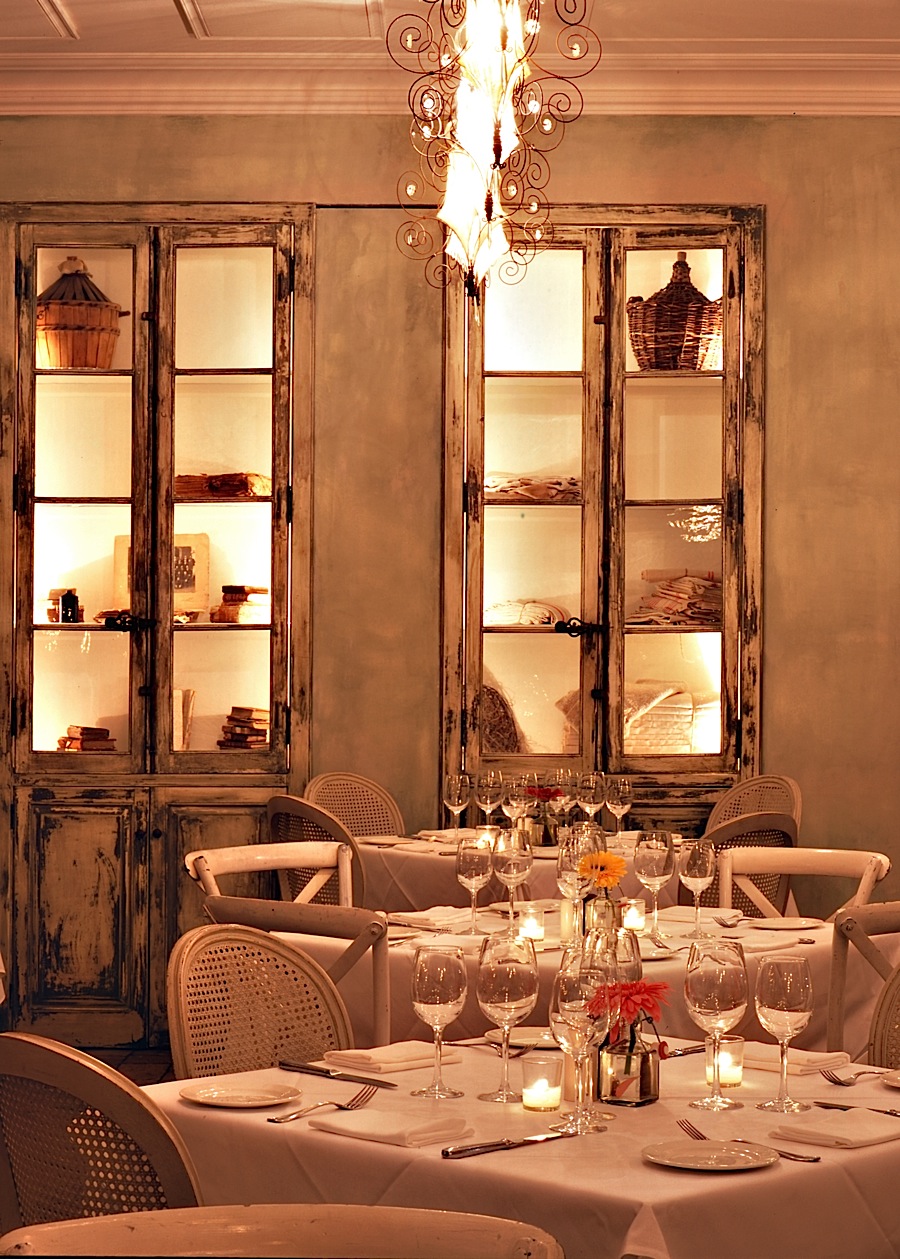
Delamar Greenwich Harbor Hotel
500 Steamboat Road
Greenwich, CT
203-661-4600
lescalerestaurant.com
L’Escale opened
earlier than Artisan but has been re-conceived since
Kieffer came aboard in
summer, 2011, and it’s now a much better focused
restaurant than it used to be.
In warm weather
everyone likes to grab an outdoor table on the
harbor, which has its summery
charms galore.
Men dress in
lockstep—tennis shirts, khakis, loafers, but the
affluent ladies of the Gold
Coast put on the summer finery here, as they do
inside now that autumn is here,
when their male counterparts switch to cable-knit
sweaters and blue blazers.
The interior is a kind
of marriage between suburban rustic and boathouse
chic, with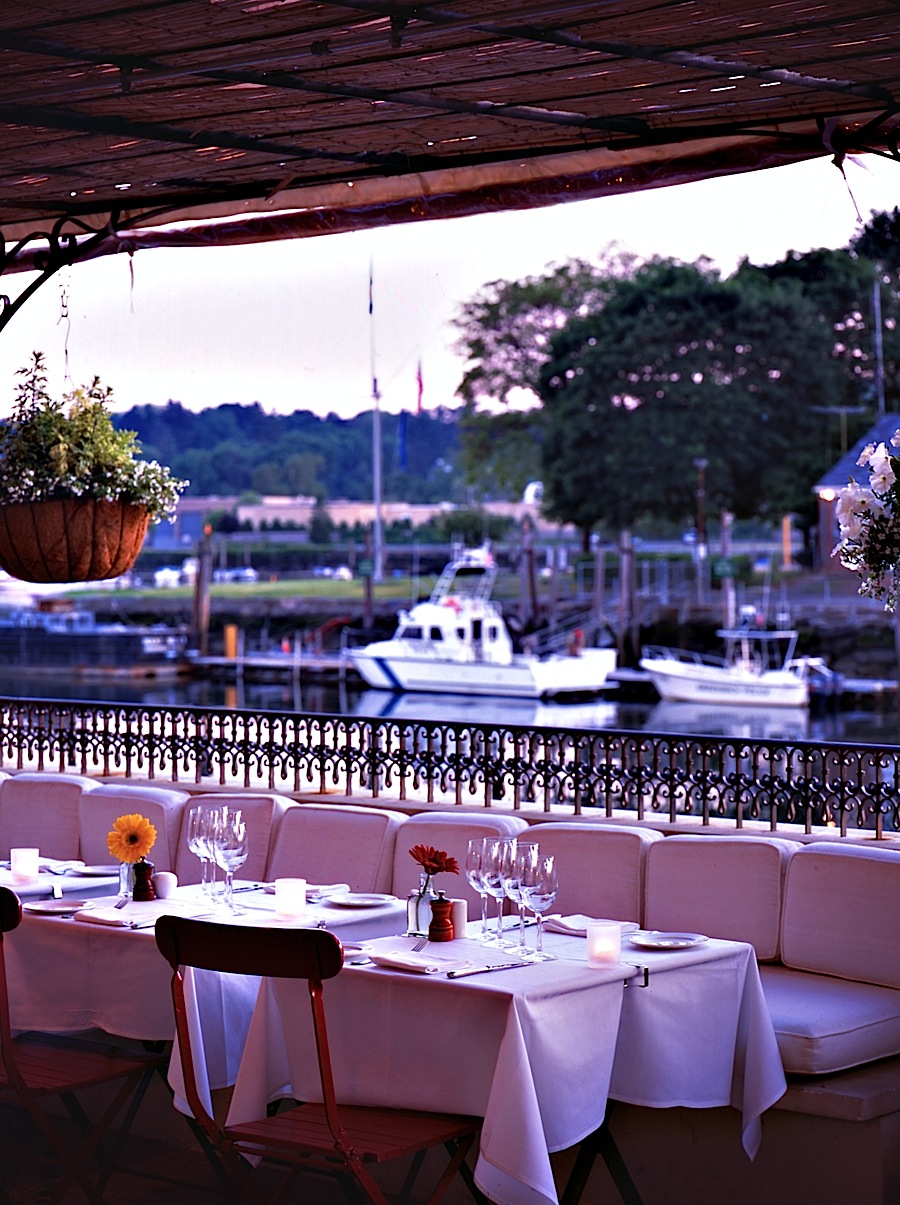 lots of distressed
old wood and bistro chairs. The bar here
gets a tony
early and late-night crowd.
lots of distressed
old wood and bistro chairs. The bar here
gets a tony
early and late-night crowd.
The
menu at L’Escale--the name means "port of call"--is
quite distinct from Artisan’s.
It’s long and offers more for everyone, and
though the dishes have
French titles with French, Italian, and American
flavors throughout,
beginning with imported (“from Italie”) burrata with
pickled eggplants.
Very good are the broiled prawns with
lemon and peppers, as are the grilled, not fried,
calamari with avocado, tomato
and basil, which you’d find on the French and
Italian Rivieras. Also go for one or two of
the daily tartares or carpaccios, each glistening
fresh and refreshing with preserved lemon, olive
oil, and herbs. I can't say the price of $150
for Chinese farmed caviar is advisable.
The lamb chops are
big, rich, well-fatted and served Provençale
style with tomatoes, fingerlings,
and a touch of rosemary in the jus, while
those craving an authentic
bouillabaisse, based on the day’s best seafood
selection, will be rewarded at
L’Escale with the traditional ruddy saffron broth
and the garlic-rich rouille and
croutons. You’ll
be just as happy
with the way French fried potatoes are done to a
golden turn.
You'd expect perfect
soufflés--here chocolate and vanilla with
pistachio sauce--and my favorite dessert,
profieroles, are stuffed with ice cream and lavished
with warm milk chocolate sauce. There are also
banana beignets and a warm apple tart.
So,
if you're feeling nostalgic for those nights in Nice
or San Remo and miss the taste of bouillabaisse, don
your blue blazer or new Ralph Lauren ensemble,
and head for L'Escale. You''ll get lost in a
reverie.
L'Escale
is open for breakfast, lunch and dinner.
Appetizers run $11-$22, entrees $14-$28.
❖❖❖
by John Mariani
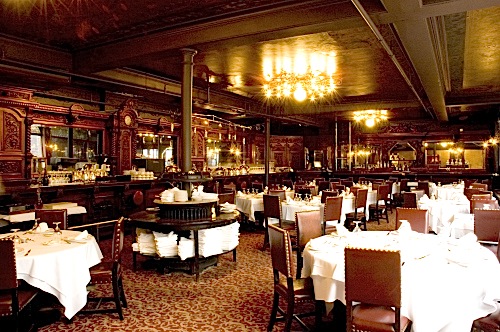 The
website
announcement sounds pretty final: “Locke-Ober is
currently closed for business
pending the sale of our building.
From all of our employees and proprietors, past
and present, we thank
you for your support and the opportunity to
respectfully serve the community of
Boston for the last 137 years.”
The
website
announcement sounds pretty final: “Locke-Ober is
currently closed for business
pending the sale of our building.
From all of our employees and proprietors, past
and present, we thank
you for your support and the opportunity to
respectfully serve the community of
Boston for the last 137 years.”
It is
always unfortunate when an historical restaurant
closes, but Locke-Ober is a
special case. It is famous for
several reasons beyond its longevity, not all of
them admirable. Alsatian-born Luis Ober took
over the
premises in 1875 on Winter Place, with money from
the owner of Jordan Marsh,
who ever afterwards had a table at the restaurant,
decorated in the Parisian
style, with expanses of mahogany, etched gold
wallpaper, an L-shaped bar, and six
silver tureens lifted by pulleys, designed by Reed
and Barton. An early tradition among diners
was to
touch  the toe of a bronze statue of
“Gloria Victus,” and a nude portrait of
“Mademoiselle Yvonne” (right)
by Tomaso Juglaris (covered with a black sash
whenever
Harvard lost to Yale) has been a symbol of the
restaurant’s genteel
hospitality.
the toe of a bronze statue of
“Gloria Victus,” and a nude portrait of
“Mademoiselle Yvonne” (right)
by Tomaso Juglaris (covered with a black sash
whenever
Harvard lost to Yale) has been a symbol of the
restaurant’s genteel
hospitality.
Frank
Locke, a saloonkeeper, joined Ober to open a
café, and after 1894 various
owners kept the restaurant thriving well into the
20th
century. The cuisine was in the French style
of
the time and didn't change much over the
decades—the current menu still lists
Dover sole, crab Louis salad, escargots
bourguignon, and its lobster stew (said
to be JFK’s favorite dish).
The place
always drew Boston’s Brahmins and important
figures visiting Boston, but
Locke-Ober’s banning of women from the downstairs
Men’s Grill (left)
until
1970 when invaded by a protest group was
a smudge mark upon the place, long after such
discrimination had disappeared in American
restaurants elsewhere.
My few
visits over the years have been hit and
miss. Back in the late 1970s, shunted
upstairs by a frowning
maître d’ well known for his lack of tact, I
found an ugly, ill-lighted room
with walls stained by rusty water.
The food was lackluster and served without the
slightest degree of
civility. Later visits at renovated premises
showed Locke-Ober to be a much
more gregarious, democratic place, but the food,
with pretty much the same menu, improved in
quality. But by the 1990s the luster
had worn off what had become a tourist restaurant,
not much improved by late
owners and chefs.
And so,
although this is not the first time Locke-Ober has
closed its doors, this may
the last call for a place rich in Boston
tradition. Like Galatoire’s and Antoine’s in
New Orleans and Delmonico’s
and `21’ Club in NYC, Locke-Ober is a reminder of
any earlier style of dining,
one too often based on preferential treatment for
some and snobbish dismissal
for others. But for the beauty of its design, now
irreplaceable, the cast of
its menu, and a place in American history, it’s a
sorry thing if Locke-Ober is
gone forever.
❖❖❖
NEW
YORK CORNER
by John
Mariani
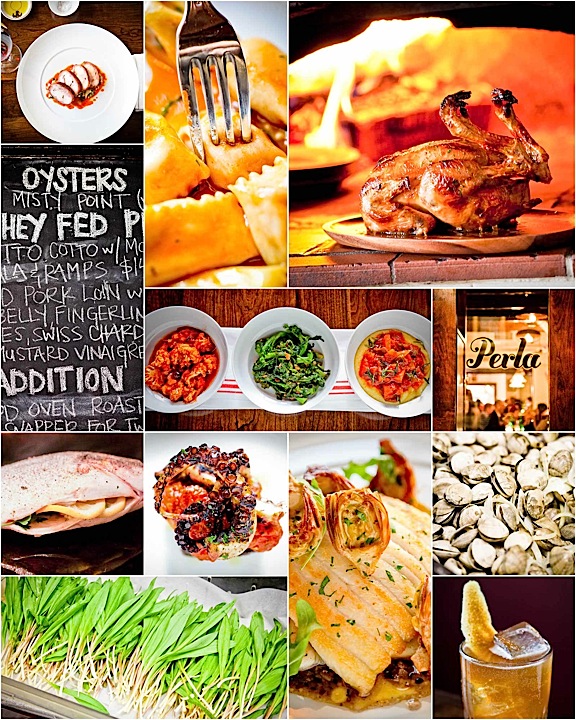 Perla
Perla
24 Minetta
Lane
212-933-1824
http://perlanyc.com
Remember
Billy Joel’s song “Scenes from an Italian
Restaurant”--“A
bottle of red, a bottle of white/It all depends upon
your appetite/I'll meet you any time you want/In our
Italian Restaurant.”?
That’s Perla, a place you’d go at the drop of
hat, the perfect little Greenwich Village Italian
restaurant, where you call ahead to owner Gabe Stulman
and ask, “Hey, is the fazzoletti
bolognese on the menu tonight?” and Gabe says,
“Yeah, I’ll save you a portion,” and you say, “Be
there in twenty,” and you get caught in traffic and
there’s a ten-minute wait, so you nurse a negroni, and
see a plate of braised octopus with oven-dried
tomatoes pass by, and you are really, deeply starving,
and so happy you’re at your favorite Italian
restaurant.d, a bottle of white/It all depends upon
your appetite/I'll meet you any time you want/In our
Italian Restaurant.”?
That’s Perla, a place you’d go at the
drop of hat, the perfect little Greenwich Village
Italian restaurant, where you call ahead to owner Gabe
Stulman and ask, “Hey, is the fazzoletti
bolognese on the menu tonight?” and Gabe says,
“Yeah, I’ll save you a portion,” and you say, “Be
there in twenty,” and you get caught in traffic and
there’s a ten-minute wait, so you nurse a negroni, and
see a plate of braised octopus with oven-dried
tomatoes pass by, and you are really, deeply starving,
and so happy 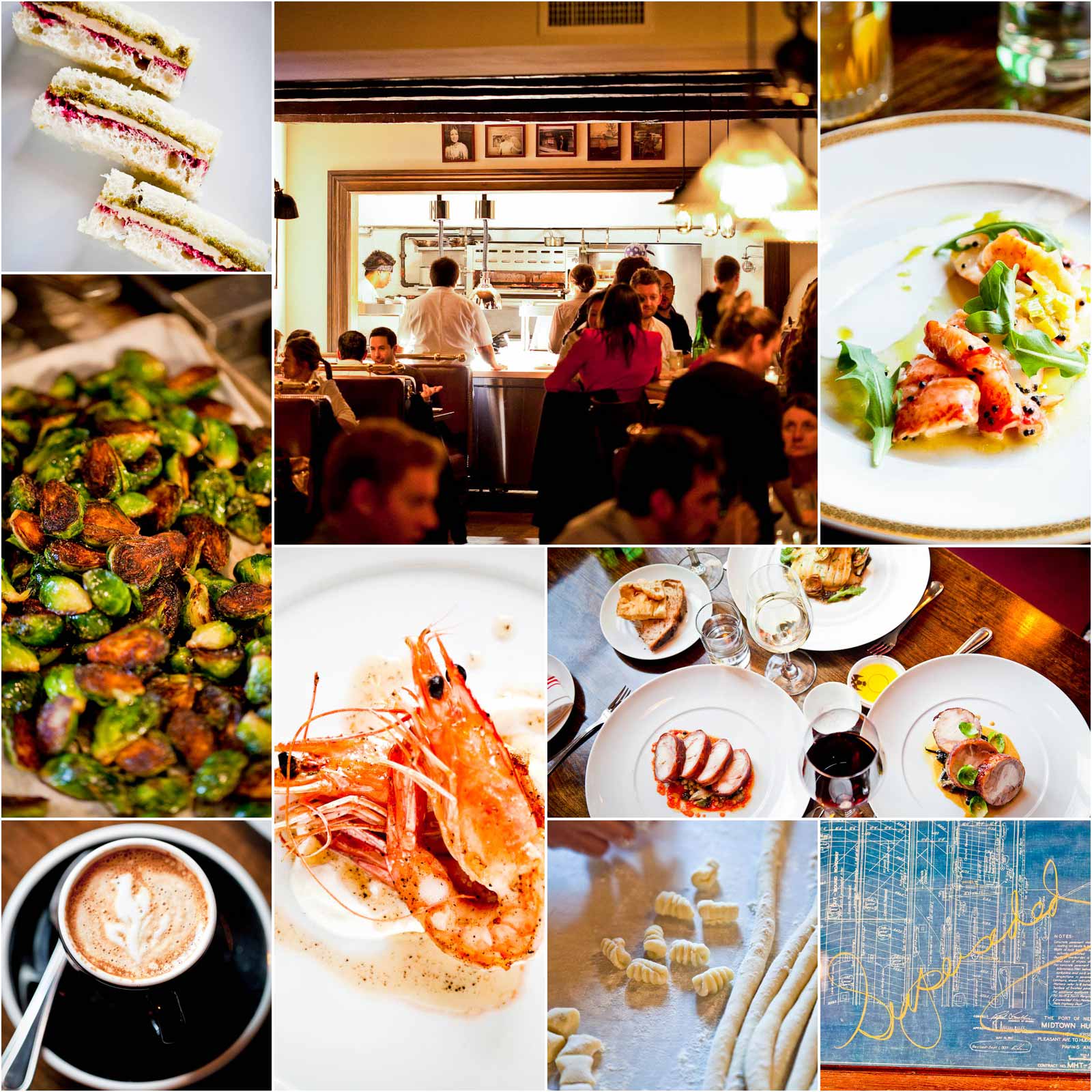 you’re at your favorite Italian
restaurant.
you’re at your favorite Italian
restaurant.
My editor and I went to Perla for a
leisurely working lunch and found we stayed later and
ate more than we'd planned, but everything on the menu
sounded so good, the aromas coming from the kitchen
were so enticing, and the wine working their way early
on, that we kept pointing to items on the menu and
kept eating. It was past three when we left,
full and smiling broadly.
What we ate, via exec chef Michael
Toscano, included irresistible foie gras
pancakes with peach and maple syrup--a dish that veers
from the basic Italian cast of the menu--and some
shrimp alla piastra,
with a fregola salad. The pizzas here are first rate
and have out-of-the-ordinary toppings, besides a fine
one in the margherita style. There's one with
"clams casino," topped with Littlenecks, sweet
peppers, and pancetta that's a must-try.
For pastas I can heartily recommend
cavatelli with
squash, arugula and pancetta,
and the black
tagliatelle with corn and Scotch bonnet
peppers. There is so much more, but it changes
so often, so just go, check out the blackboard items
for the day, order anything. You won't go away hungry.
Perla is open for lunch
Fri.-Sun., for dinner nightly. At dinner antipasti
run $12-$15, pastas $18-$26 and main courses
$24-$32.
❖❖❖
NOTES FROM THE WINE CELLAR
Morellino Di Scansion
by Mort Hochstein
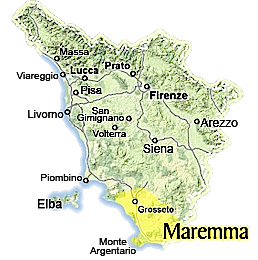 When I’m asked to
suggest an inexpensive red wine, I normally recommend Montepulciano
d’Abruzzo, which hovers in price around the very
sweet spot of $12. Friends
have been
praising Grifone
Primitivo, from Roccadero in Puglia, which has been
roaring off the shelves at an incredible $3.99 from
Trader Joe in Manhattan, reminding me of the fuss a
few years ago over
Two-Buck Chuck, aka Charles
Shaw, notorious at that
ridiculously low price in California
and for
a buck or two more
in New
York and other regions.
When I’m asked to
suggest an inexpensive red wine, I normally recommend Montepulciano
d’Abruzzo, which hovers in price around the very
sweet spot of $12. Friends
have been
praising Grifone
Primitivo, from Roccadero in Puglia, which has been
roaring off the shelves at an incredible $3.99 from
Trader Joe in Manhattan, reminding me of the fuss a
few years ago over
Two-Buck Chuck, aka Charles
Shaw, notorious at that
ridiculously low price in California
and for
a buck or two more
in New
York and other regions.
Recently
I found a new family of wines which are also in the Montepulciano
price range,
depending on
quality
and where you shop. Like those
from Abruzzo, they are
light, fruity and easy drinking. These are
the wines of Morellino
Di Scansano,
coming from the Tuscany Maremma, a region known for its fine horses
and Tuscan cowboys, where wild boar is often
featured on the dinner plate along with seafood from
the Tyrrhenian Sea. The
nearby seacoast is a favorite of Italians and
Scandinavian refugees from long cold winters.
Morellino wines have been
available, though
often overlooked, in
the American market for years. Wine
merchants tell
me customers today have
become more aware and are
moving toward them because of
their price and
value. Knowledgeable
restaurateurs attracted
by low cost and their easy
drinking characteristics, have long favored them,
particularly for wine by the glass options.. More
Morellinos of higher quality are increasingly
available as several
of
Italy’s major producers have entered the arena, drawn
by inexpensive
land with good potential .Those heavyweights include
Jacopo Biondi-Santi
of Montalcino, who’s been producing a high-end
Scansano listing
at $45, and others such as Castello di Romitorio of
Chianti and Fattoria
dei Barbi of Montalcino.
The
region’s winemaking provenance flows back to the time
of the Etruscans, that strange yet rich civilization
which preceded the Roman era. Researchers
unearthing
Etruscan tombs and
deserted fields have found earthenware jars holding
grape seeds, vineyard tools, 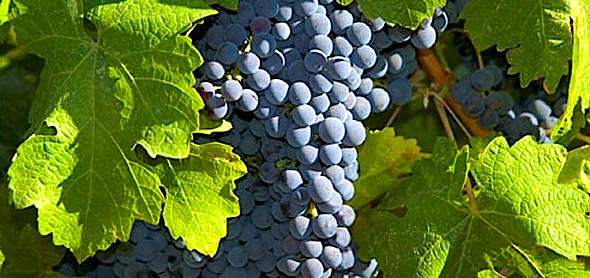 kilns and other
wine-related artifacts dating back to the fifth
century. Romans
conquered the Scansano territory circa 280 BC and
produced wine destined for the empire’s western provinces.
When Rome
fell, the region declined and the population
shrank as people abandoned the region to escape flooding
and swamps in coastal
areas. Until
relatively recently, only a handful of growers remained,
producing primarily
for their own and local
consumption. Morellino (right), one of
the many clones
of Sangiovese, takes its name from horses named
Morelli, used
to pull the carriages of locals fleeing the
malaria-infested swampy coastal region for higher
ground at Grosetto.
kilns and other
wine-related artifacts dating back to the fifth
century. Romans
conquered the Scansano territory circa 280 BC and
produced wine destined for the empire’s western provinces.
When Rome
fell, the region declined and the population
shrank as people abandoned the region to escape flooding
and swamps in coastal
areas. Until
relatively recently, only a handful of growers remained,
producing primarily
for their own and local
consumption. Morellino (right), one of
the many clones
of Sangiovese, takes its name from horses named
Morelli, used
to pull the carriages of locals fleeing the
malaria-infested swampy coastal region for higher
ground at Grosetto.
The number of vineyards and
producers increased
dramatically after 2007 when the region’s wines were
elevated to DOCG status. Morellino could be called a
‘new-old’ vineyard region, since nearly 80%
of its fields were
given over to grapes vines only in 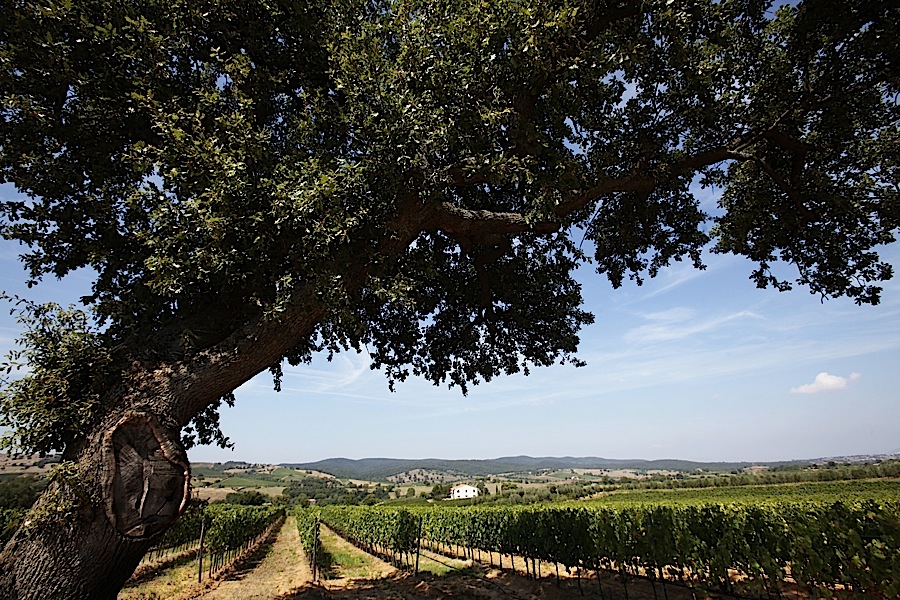 the last two
decades. At
a recent count,
there were 520 growers producing more than
two million gallons and close to 11 million bottles of
wine annually.
Very little Morellino is sold in bulk.
the last two
decades. At
a recent count,
there were 520 growers producing more than
two million gallons and close to 11 million bottles of
wine annually.
Very little Morellino is sold in bulk.
We tasted a batch of Morellino
wines in early October at the Cork Buzz winebar in New York
City. Though they came
from different vineyards
, some hilly, some low lying, some coastal, they were
uniformly fruit
forward, velvety, and extremely
approachable Under
DOCG regulations, 85% of grapes must be Sangiovese, and most
are blends using Cabernet Sauvignon, Syrah, Merlot
and, occasionally, Alicante. These are not wines for
laying down and should not be
held more than five years. We tasted just one 100%
Sangiovese, Terre di Fiori Ventaio 2009 , with
a distinctive floral aroma. It is a supple,
elegant wine
from a single vineyard benefiting from partial
aging in oak
Moris Farms 20ll, Sangiovese
with a helping of
Cabernet and Syrah, boasting blueberry,
blackberry spicy qualities was our opener and it set a pattern
of easy approachability for the wines that
followed. Our favorite was the oldest wine we sampled,
Poggio Valente Riserva 2008 from Fattoria Le Pupille,
Sangiovese given added
power, spice
and body from Syrah
and Alicante. It was delightfully smooth on the
palate, with gin-like hints of juniper. For the wine
fan seeking a broader spectrum, Scansano would be
worth a detour on
the wines shelves and on the roads of Italy.
❖❖❖
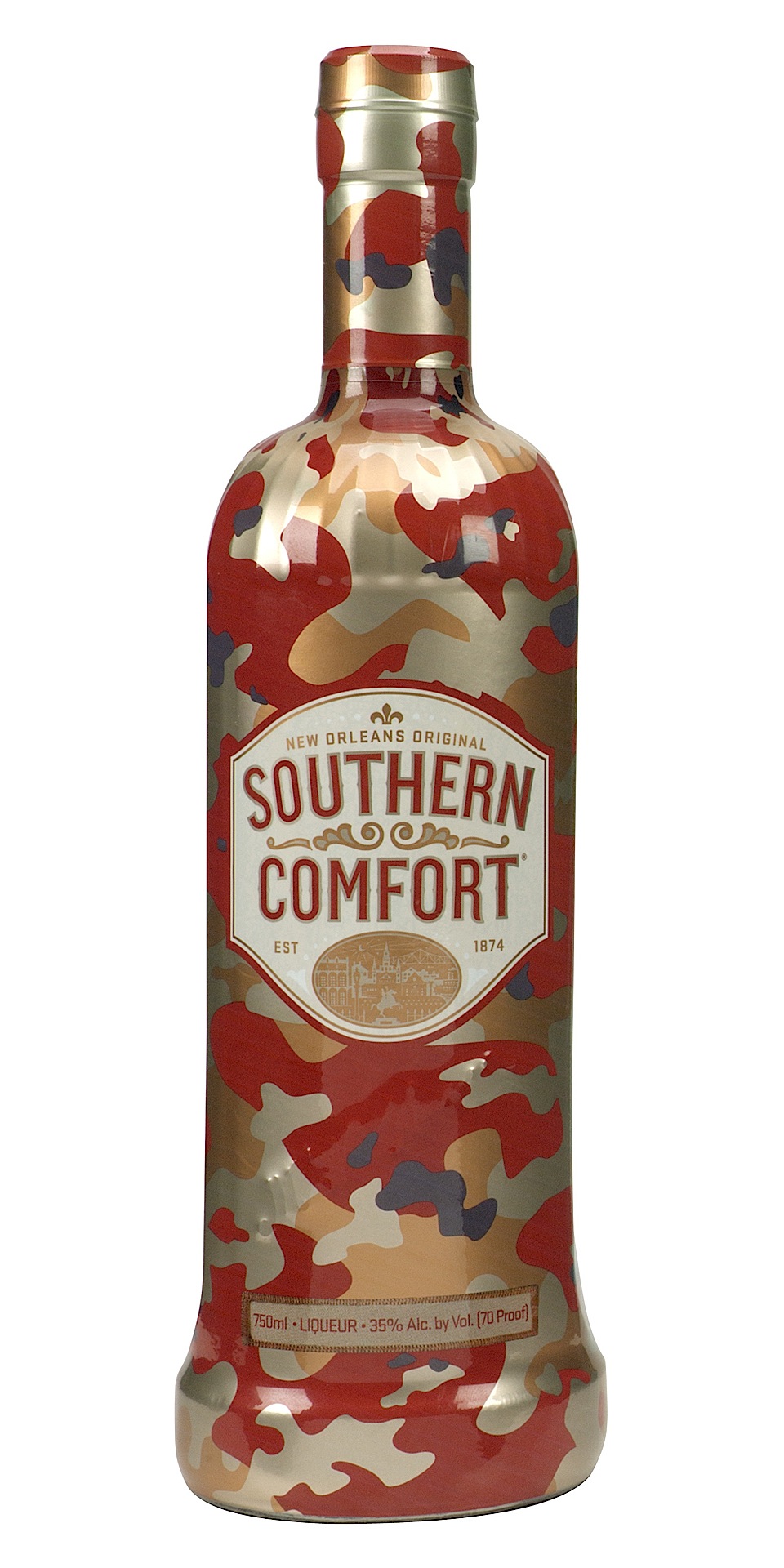
DEPARTMENT OF REALLY, REALLY BAD TASTE
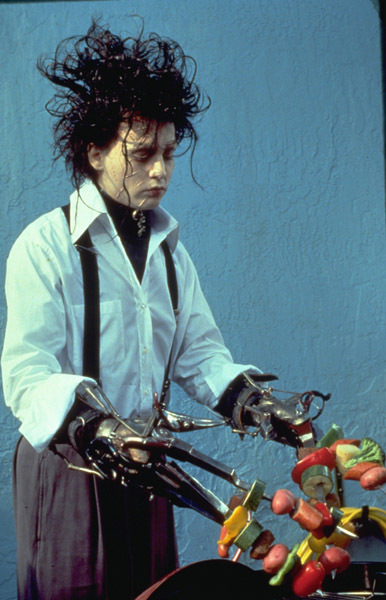 RESTAURANT
REVIEWS WE
RESTAURANT
REVIEWS WE
NEVER FINISHED READING
“Shish
kebab and sunshine are hot right now.”
—Cal Foster, “Pleasanton on the Mediterranean,”
Diablo
Magazine (Sept. 2012).
❖❖❖
Any of John Mariani's
books below may be ordered from amazon.com.
 |
My latest book, which just won the prize for best book from International Gourmand, written with Jim Heimann and Steven Heller, Menu Design in America, 1850-1985 (Taschen Books), has just appeared, with nearly 1,000 beautiful, historic, hilarious, sometimes shocking menus dating back to before the Civil War and going through the Gilded Age, the Jazz Age, the Depression, the nightclub era of the 1930s and 1940s, the Space Age era, and the age when menus were a form of advertising in innovative explosions of color and modern design. The book is a chronicle of changing tastes and mores and says as much about America as about its food and drink.
“Luxuriating vicariously in the pleasures of this book. . . you can’t help but become hungry. . .for the food of course, but also for something more: the bygone days of our country’s splendidly rich and complex past. Epicureans of both good food and artful design will do well to make it their coffee table’s main course.”—Chip Kidd, Wall Street Journal.
“[The menus] reflect the amazing craftsmanship that many restaurants applied to their bills of fare, and suggest that today’s restaurateurs could learn a lot from their predecessors.”—Rebecca Marx, The Village Voice. |
"Eating Italian will never be the same after reading John Mariani's entertaining and savory gastronomical history of the cuisine of Italy and how it won over appetites worldwide. . . . This book is such a tasteful narrative that it will literally make you hungry for Italian food and arouse your appetite for gastronomical history."--Don Oldenburg, USA Today. "Italian
restaurants--some good, some glitzy--far
outnumber their French rivals. Many of
these establishments are zestfully described
in How Italian Food Conquered the World, an
entertaining and fact-filled chronicle by
food-and-wine correspondent John F.
Mariani."--Aram Bakshian Jr., Wall Street
Journal.
"Equal parts
history, sociology, gastronomy, and just
plain fun, How Italian Food Conquered the
World tells the captivating and delicious
story of the (let's face it) everybody's
favorite cuisine with clarity, verve and
more than one surprise."--Colman Andrews,
editorial director of The Daily
Meal.com. "A fantastic and fascinating
read, covering everything from the influence
of Venice's spice trade to the impact of
Italian immigrants in America and the
evolution of alta cucina. This book will
serve as a terrific resource to anyone
interested in the real story of Italian
food."--Mary Ann Esposito, host of PBS-TV's
Ciao
Italia. "John Mariani has written the
definitive history of how Italians won their
way into our hearts, minds, and
stomachs. It's a story of pleasure over
pomp and taste over technique."--Danny Meyer,
owner of NYC restaurants Union Square Cafe,
Gotham Bar & Grill, The Modern, and
Maialino.
|
 |
 |
 |
 |
 |
 |
 |
 |
 Everett Potter's Travel Report:
Everett Potter's Travel Report: 
 Eating Las Vegas
is the new on-line site for Virtual Gourmet
contributor John A. Curtas., who since 1995
has been commenting on the Las Vegas food
scene and reviewing restaurants for Nevada
Public Radio. He is also the
restaurant critic for KLAS TV, Channel 8 in
Las Vegas, and his past reviews can be
accessed at KNPR.org.
Click on the logo below to go directly to
his site.
Eating Las Vegas
is the new on-line site for Virtual Gourmet
contributor John A. Curtas., who since 1995
has been commenting on the Las Vegas food
scene and reviewing restaurants for Nevada
Public Radio. He is also the
restaurant critic for KLAS TV, Channel 8 in
Las Vegas, and his past reviews can be
accessed at KNPR.org.
Click on the logo below to go directly to
his site.

Tennis Resorts Online: A Critical Guide to the World's Best Tennis Resorts and Tennis Camps, published by ROGER COX, who has spent more than two decades writing about tennis travel, including a 17-year stretch for Tennis magazine. He has also written for Arthur Frommer's Budget Travel, New York Magazine, Travel & Leisure, Esquire, Money, USTA Magazine, Men's Journal, and The Robb Report. He has authored two books-The World's Best Tennis Vacations (Stephen Greene Press/Viking Penguin, 1990) and The Best Places to Stay in the Rockies (Houghton Mifflin, 1992 & 1994), and the Melbourne (Australia) chapter to the Wall Street Journal Business Guide to Cities of the Pacific Rim (Fodor's Travel Guides, 1991).


MARIANI'S VIRTUAL GOURMET
NEWSLETTER is published weekly. Editor/Publisher: John
Mariani.
Contributing Writers: Christopher Mariani, Robert Mariani,
John A. Curtas, Edward Brivio, Mort Hochstein,
Suzanne Wright, and Brian Freedman. Contributing
Photographers: Galina Stepanoff-Dargery,
Bobby Pirillo. Technical Advisor: Gerry McLoughlin.
© copyright John Mariani 2012
